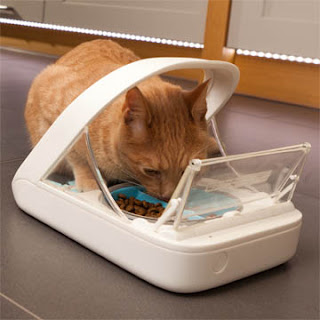One of the
highlights of Christmases past has been watching my pets open their gifts. My
favorite memory is of my gentle dog, Chris, frantically tearing at the wrapping
paper while making excited wuffing noises. Upon opening the package and finding
his favorite fleece Chewman toy, he trotted merrily around the house,
continuously squeaking it. The grand finale was when he removed the noise maker
with surgical precision. A short-lived plaything, but his joy made it worth
every penny.
Not only do
dogs and cats enjoy opening presents, but their people do, too. And dog and cat
owners appreciate pet-related gifts. To that end, I’ve been keeping a list of noteworthy
goods that are veterinarian approved ─ by me, of course!
Here are my
top picks for Christmas, 2015:
I love these elegant 12-ounce microwave- and dishwasher-safe mugs. They’re chic and come individually packaged in brightly colored artsy boxes.
Kyjen Outward Hound Port-a-Bowl $4 - $17
A must for the active outdoor dog! It dries quickly and collapses to fit in your packpack, pocket, or purse, and it can be used for food or water on the go. Every pooch can use a refreshing drink of water during his walk on a hot day.
Cat climber (Door Hanger) $99.95
I wish that I had thought of this – brilliant! This cat tree fits a standard 80-inch door, but its spring-loaded bracket system allows it to adjust to similar-size doors. And the post is made of sisal for scratching. Move it from door to door to give your cats a new view.
Show off your pet every time you pick
up your cell phone: Have his or her picture incorporated into a custom
Renaissance portrait for your iPhone or Samsung Galaxy phone case. Choose among
characters such as a king, queen, guard, beggar, saint, jester, maid, or
general ─ from humble quadruped to King Henry VIII in the blink of an eye!
Sleepypod mobile pet bed $139.99-$179.99
It’s a bed! It’s a carrier! It’s a safe car seat! It’s all
three products in one. Turn it from a bed into a carrier by zipping on the mesh
dome. A seat belt can be fastened through the handle for travel. I especially
love this for cats, who will enjoy traveling in the comfort and familiarity of
their own bed. What a great way to reduce stress on those visits to the vet!
Veterinarians
recommend fountains to encourage water drinking, especially for senior cats and
dogs. My objection to the ones that I’ve owned is that they get slimy and are
hard to clean. And they’re ugly! Drinkwell
has come out with a fountain with simple, elegant lines. Not only is it
attractive, it’s made of easy-to-clean ceramic, and it’s dishwasher safe. It
has an upper and lower dish to accommodate both small and medium-sized pets.
The carbon water filter helps keep the water fresh.
Wheel House Socks $10.95
These comfy socks come in multiple sizes and colors. With dozens of breeds from which to choose, they're the perfect stocking stuffer for the dog lover in your life.
Rope Slip Lead, 4 feet and 6 feet $7.99
Happy shopping, and happy holidays to you and your family members, including the furry ones!
These comfy socks come in multiple sizes and colors. With dozens of breeds from which to choose, they're the perfect stocking stuffer for the dog lover in your life.
Zogoflex $7.95 - $10.95
I researched the best chew toys for dogs
in a previous post, and these came out on top. They won’t fracture teeth, and they’re environmentally friendly: When you send your worn-out Zogoflex toys
back to the company, West Paw recycles them into new ones. They come in a
variety of colors and shapes, so there’s a good chance you’ll find one that
your buddy approves of.
Interactive feeding toys
help slow hasty eaters, and this one makes meals more interesting. Your dog
will learn to turn the revolving sections to reveal his vittles. The Tornado
allows you to gradually increase the level of difficulty as his skill improves.
Dogs like to have a job, and this feeder gives them a sense of accomplishment.
Rope Slip Lead, 4 feet and 6 feet $7.99
A humble gift, yes, but one
much favored by veterinarians, shelters, and trainers. We use these at Vernon
Hills Animal Hospital. When our clients feel how soft and well made these rope
leads are, they invariably ask where we got them and buy a couple for
themselves.
Do you have a feline food bully at home who
nudges your other cats out of the way and eats too much food? I do, so when I
saw this microchip feeder I had to have it! It works with your cat’s existing microchip (or
we can insert one for you) or with the included tag. When your pet approaches
the feeder, a covering slides up and allows her to eat. When she’s finished, it
quietly closes. The two bowls, which are suitable for both dry and wet food,
seal tightly to ensure freshness. I love that it runs on batteries, so there
are no cords.
If you think $149 is pricey, consider the financial implications of diabetes and other obesity-related diseases, which can cost hundreds of
dollars in vet bills every year. Now our clients whose cats are on weight-loss
and prescription diets won’t be able to steal other cat’s food and overeat. Awesome!
Pet Tree
Houses $199-$1999
Ridiculously expensive, but so cool I just
had to include these. They’re made from real trees embellished with silk
foliage to give your feline friend a lifelike experience. The trunk can be used
as a scratching post. But there’s no need to spend megabucks to own one. For
someone good at woodworking, I think this would be a fun, reasonably priced do-it-yourself
project.
Happy shopping, and happy holidays to you and your family members, including the furry ones!


















